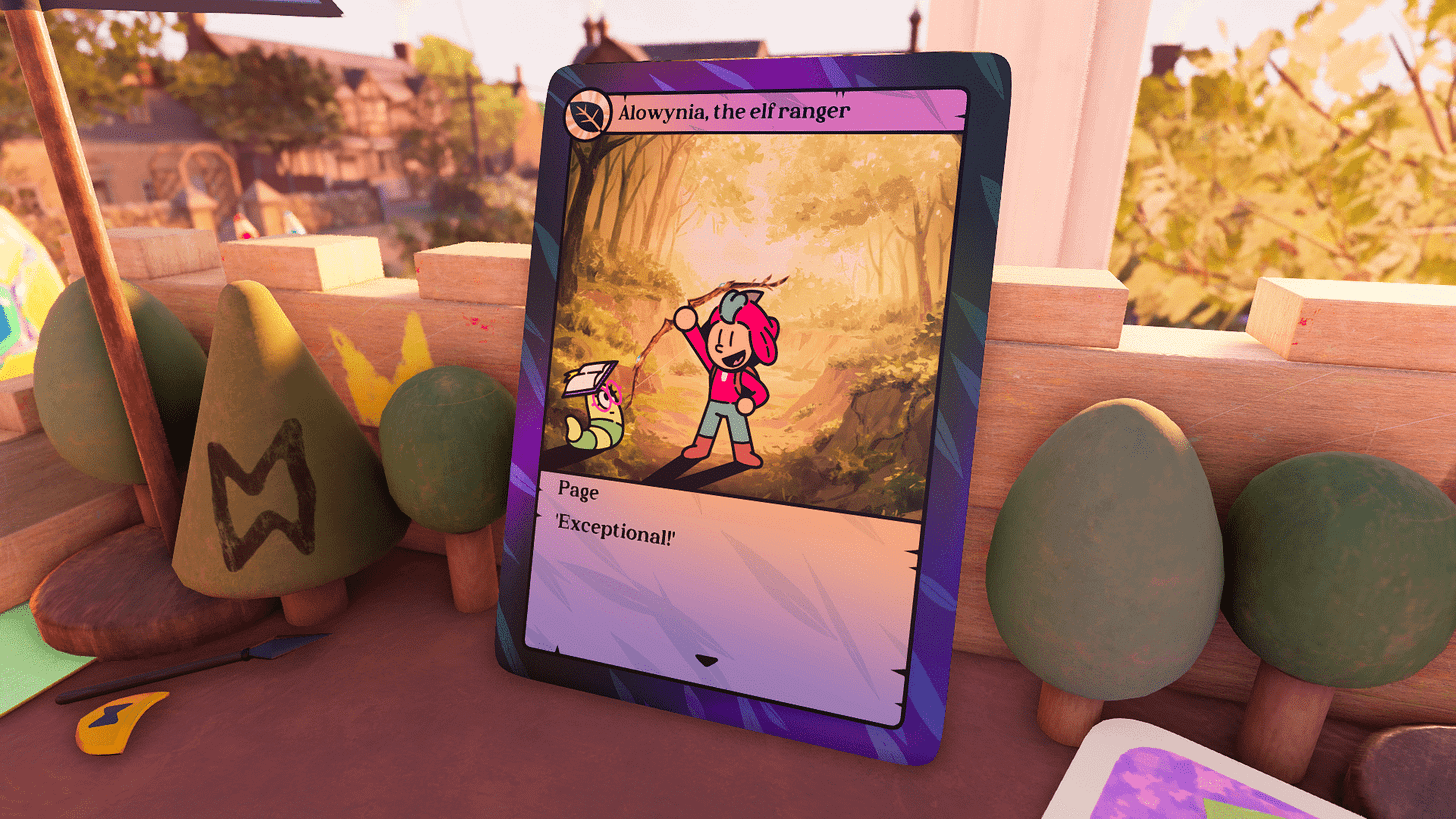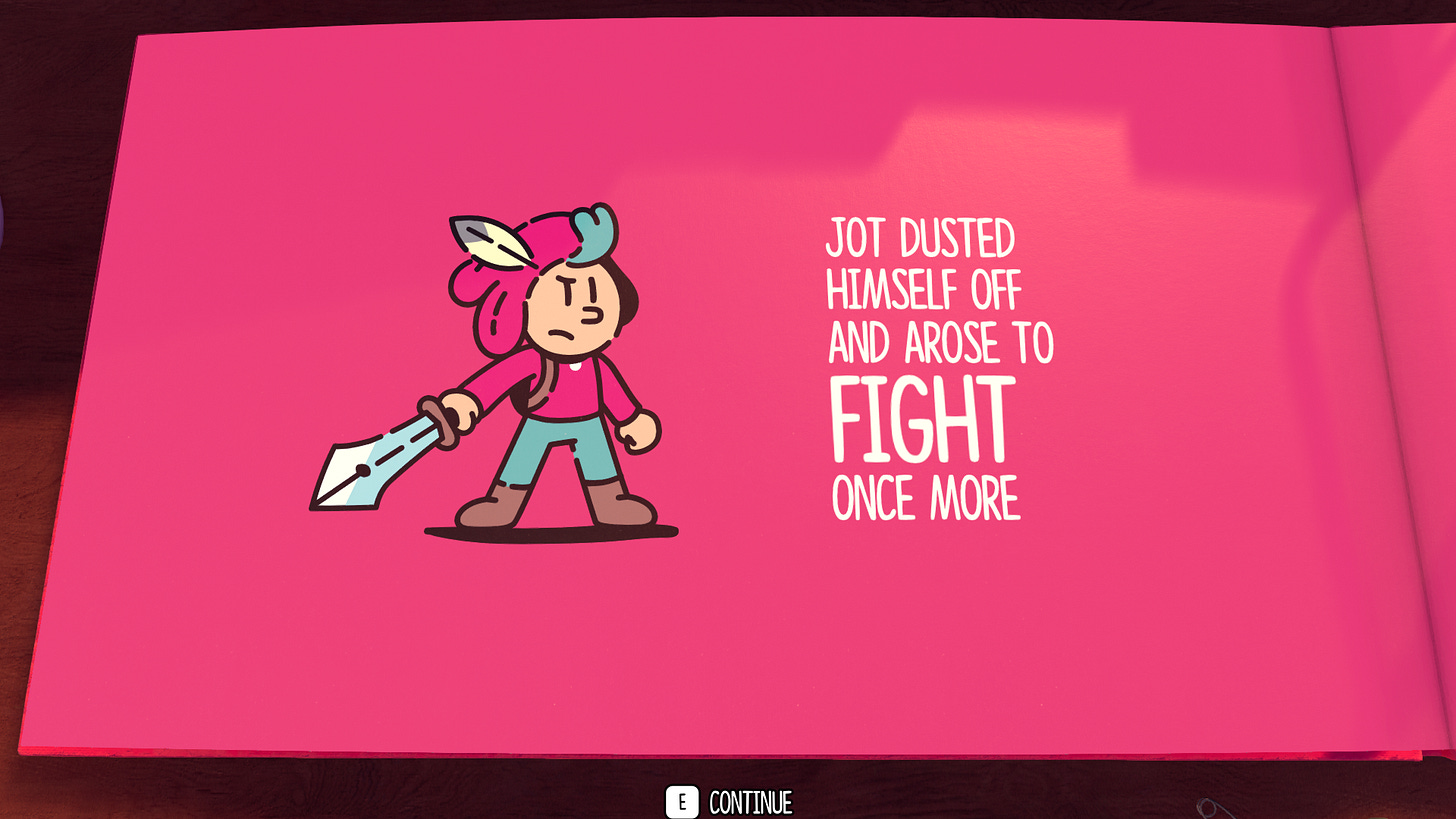I was interested in The Plucky Squire from the beginning. The whole storybook-come-to-life premise, with eye-catching visuals, had me wishlisting it immediately. Add the concept of blending 2D and 3D worlds together, and now my wallet's getting a bit nervous. At $30, everything sounds great on paper, yet with every hour of my nine-hour playthrough, my joy slowly faded into disappointment— as I found out the game doesn’t truly jump off the page.
Let’s start at the beginning. You play as Jot, a squire who quickly discovers he’s part of a book where he is the protagonist. Jot also happens to be a writer, which foreshadows his connection to Sam, the kid who writes The Plucky Squire. Which is weird because Sam’s isn’t ever in-game, he’s only mentioned by name. While battling the evil Humgrump, Jot gets blasted out of the book and into Sam’s desk in the real world. With the support of Moonbeard (the local sorcerer), Violet (an artist witch), and Thrash (a rock-and-roll troll), you must defeat the evil wizard to restore your world to normal.
You’ll spend the majority of your time in 2D, occasionally swapping into the 3D world when exiting the book. Truth be told, the inside of the storybook is a million times better. The 2D illustration and cartoon aesthetic is bright, inviting, and has an overall lovely, artsy vibe. That’s not to say the 3D counterpart isn’t well done, but it doesn’t quite hit the same level. Yes, there’s a sense of carefully crafted detail that brings the desk to life, especially in the later chapters. However, the 2D worlds have such vivid charm that perfectly connects with the children’s book aesthetic. Meanwhile, outside of the book, it’s a different tone, with smaller details like scuffs on cards and open containers of ink that somewhat transfer immersion.
The 3D world is also annoying as hell. Nine times out of ten, traveling outside of the book results in an irritating quest. As soon as a new power is introduced, Jot is forced out of the book to fetch it. The desk then shifts and adjusts the platforms that you’ll eventually overcome. While the narrative tied to these moments is lovely, it makes the 3D world feel like a gimmick. Even if you fundamentally disagree and love the 3D world, you’re getting it in small, bite-sized pieces that feel like a chore. It just doesn’t have the same appeal once you’ve seen how the sausage is made.
It also isn’t a fair comparison, as most of the people who matter to Jot are confined to his 2D home world. Most of his friends, writings, and adventures take place in this artbook, where everyone knows him as a brave hero. The exposition and lore paint Jot as this amazing writer and hero that everyone admires and appreciates. I mean, why would you ever want to leave?
Back in the 3D world, there are beetles, a few enemies to pummel, and fetch quests. Exploration? Never heard of it. You’re limited to the desk, which was so disappointing. It’s not even a cool desk; it’s just messy and lacks personality. I tried to jump off the desk to see what other goodies Sam has in his room, maybe meet a toy or something. Instead, I was stuck fetching powers in a very predictable fashion.
I understand the appeal of the plot, but it didn’t connect with me. Narratively, everything in this game is told through a rose-colored lens, where failure is merely an obstacle along the journey. Powerful for the E10 demographic, but not engaging enough for me. Listen, I love "power of friendship" storylines as much as the next geek, but it has to be done right. Sprinkle in some suspense, and start showing rather than telling or hand-holding throughout. It makes a world of a difference.
Perhaps I’m being too harsh, but anytime I can predict major story beats, the immersion is stripped away, and I’m an unhappy camper. This is exactly what I experienced with the main plot. Part of me understands the narrative is a bit cheesy, and I shouldn’t expect too much. Yet, as I progressed through each chapter, I started guessing what was going to happen, and I was genuinely surprised only once before the big boss battle in chapter nine. I craved a rich, flavorful ice cream, but instead, I got plain old vanilla. I’m not mad. I’m just disappointed.
With the plot not exactly being a page-turner, I wasn’t thrilled to write this review. Things only get worse when reflecting on the simplicity of the overall experience. Imagine a seven-hour tutorial and one hour of pure gameplay with no strings attached—doesn’t sound so appealing, right? Unfortunately, that’s what you get here, which is criminal because the game felt like it promised a jam-packed experience full of freedom, cutesy vibes, and engaging gameplay. Instead, I was spoon-fed a bland, underwhelming experience that left a sour taste in my mouth.
Don’t even get me started on the gameplay, unless you’re a sucker for rinse-and-repeat fights. Same enemies, same tactics, same movement—it’s all too repetitive. Puzzles help break up the monotony, but there’s no real sense of difficulty. The more I was ping-ponged between basic gameplay and Dora the Explorer-grade puzzles, the more I realized this just isn’t for me. Basic and mundane isn’t a combination that should be served and it’s the only thing on the menu. I won’t fault anyone for eating the meal if they’re hungry, but there are better establishments to dine at for the same cost.
Here’s my biggest gripe with The Plucky Squire – there’s a lot of visual eye candy but no real substance.. It’s fun for the first three or four hours, but it loses momentum midway. Even with new abilities being introduced later, I still hit that wall. One could counter argue that the worlds were optimized and constructed for major story beats, so we could learn more about your friends’ history, which resulted in more levels. It’s supposed to pay off in the end when we learn the book has expanded to The Plucky Squire and friends. I understand and respect that line of thinking, but it ultimately padded the runtime.
Sidebar: I primarily cared for Thrash and Violet and was sold on the trio’s connection in the second chapter. Again, Jot is essentially mute, so having his friends as mouthpieces brimming with personality is a must. I was sold on Thrash being a rocker troll and Violet being an aspiring witch primarily through dialogue and interactions. Yet, there are individual chapters for each of your crew, and truth be told, they felt like filler TV episodes. Violet and Thrash face the same threats in two different chapters, and I couldn’t tell you why. End of sidebar.
Add in the tropes thrown into the plot, and it makes my eyes roll back like the Undertaker. Humgrump (the evil wizard) is the brother of Moonbeard (the good wizard) – oof, unoriginal. Oh, and Humgrump kills Moonbeard because he’s in the way – ooh, I’m pulled back in. But then Moonbeard comes back to assist, as he’s not truly dead. Ah, downgrade: bait and switch. We also learn Humgrump is a misunderstood poet who was rejected, and that’s why he became evil. I’m going to contact Pixar and let them know they borrowed Syndrome from The Incredibles.
The Plucky Squire is beautiful, but beyond basic, and it really kills me to admit that. The charm, the bold colors, the vibes—they're all intact, but their impact is minimal. I wish the developers didn’t treat players like it’s their first time holding a controller and had trimmed the excess bloat. Cutting out the hand-holding, fluff, and offering proper exploration outside of the storybook would have been closer to what was marketed. I feel like I was pitched a decent home-cooked meal, but instead, I got a bag of stale party potato chips with 80% of the package being air. I appreciate the offer, but I’m saving my appetite for a proper meal.
Pros
Well-crafted 2D aesthetic
Engaging supporting characters
Cons
Underwhelming gameplay
Disappointing 3D world
Lack of exploration
Predictable narrative
Excessive hand-holding
Uneven pacing











well written Will! look forward to more reviews
Hi Will, can you clear something up for me, I'm confused. Sebastian Ruiz (aka Frost) linked this as his substack, are you two co-writing this blog?